BRIDGES
|
Albert Bridge
Chelsea/Battersea, London
SW3 and SW11
|
|
|
|

|
|
Spanning the Thames from Chelsea to Battersea, the stunning Albert
Bridge is without doubt London's prettiest
bridge.
In 1983 it was repainted in
delicate ice cream colours and Albert
Bridge adds great variety to the London river
scene. At night the elegant floodlit structure is beautifully reflected
in the swirling water below.
A 1864 Act of Parliament
authorised the construction of a bridge but there were long delays before it
was opened to traffic in 1873.Designed by Roland Mason Ordish, Albert Bridge
was originally a cantilever bridge, with each half of the bridge being
supported by bars radiating out from the top of its supporting towers.
 The 710 ft long bridge was made up of two side
spans of 155 ft and a centre of 400 ft. The roadway was 41 ft in width.
Built in a grand Victorian manner, the bridge was finished with
lanterns and topped by ornate pagodas giving it a vaguely oriental
appearance. The 710 ft long bridge was made up of two side
spans of 155 ft and a centre of 400 ft. The roadway was 41 ft in width.
Built in a grand Victorian manner, the bridge was finished with
lanterns and topped by ornate pagodas giving it a vaguely oriental
appearance.
The Albert Bridge Company were
also made responsible for up-keep of Battersea Bridge
but the company could not afford to maintain either with the revenue raised
by toll charges. In 1878 both bridges were purchased by the
Metropolitan Board of Works and in 1879 became toll-free.
In 1884 Sir Joseph Bazalgette
strengthened and modernised Albert
Bridge and his
modifications made the structure more like a conventional suspension
bridge. At the same time a 5 ton weight limit was imposed on
vehicles. For the following 60 years the bridge was well
maintained.
After World War II the Victorian
bridge was too weak to bear the increased weight of modern traffic.
When the LCC announced that they intended to demolish Albert
Bridge there was a huge outcry from
the Chelsea
conservationists, led by Sir John Betjeman. Fortunately the
conservationists overcame the town planners and Albert Bridge
was saved. As a result Albert Bridge is the only bridge in central London never to have
been replaced.
In 1973 the bridge was reopened
to light traffic after two concrete piers were constructed under the main
span to give the bridge added support. In addition, a new lighter deck
was laid and the weight limit reduced to 2 tons.
At each end of the bridge is a
notice instructing the soldiers of nearby Chelsea Barracks to break step when
marching over the bridge. It is thought that the vibrations caused by
marching in step would damage the delicate structure.
|
|
Blackfriars Railway
Bridge
Blackfriars and Southwark, London
SE1 and EC4
|
|
|
|

|
|
In 1860 the London Chatham &
Dover Railway (LDCR) was allowed to build an extension from its existing
station at Beckenham to Ludgate Hill in the City of London. The new railway line would
cross the Thames beside Blackfriars
Bridge.
As the road bridge was being
rebuilt by Joseph Cubitt, it was agreed that he should design both
bridges. Work started on the railway bridge in 1862 and the bridge and
the station, then called St Paul's,
opened in 1864.
The wrought-iron girder railway
bridge has spans supported by masonry abutments and composite piers.
Since the bridge formed part of St
Paul's Station it was given a great deal of
cast-iron ornamentation. The supports had ornate Romanesque capitals
and decorated with large, brightly coloured shields incorporating the
coat of arms of the LCDR.
 The Blackfriars Railway
Bridge carried only
four tracks and 20 years later it was decided to construct a second railway
bridge beside the first. Designed by W. Mills, the new wrought-iron
bridge opened in 1886. Its river spans match the old bridge, and on the
downstream side the bridge is decorated with pulpit turrets, while on the
upstream side there are Gothic-style cast-iron parapets. The Blackfriars Railway
Bridge carried only
four tracks and 20 years later it was decided to construct a second railway
bridge beside the first. Designed by W. Mills, the new wrought-iron
bridge opened in 1886. Its river spans match the old bridge, and on the
downstream side the bridge is decorated with pulpit turrets, while on the
upstream side there are Gothic-style cast-iron parapets.
Following the re-organisation of
the railways in 1923, the new Southern Railway decided to concentrate all its
long-distance and Continental traffic at Waterloo
and Victoria. As
a result St Paul's
Station lost all but its local and suburban services.
In 1937 St
Paul's Station was renamed Blackfriars
Station and the St Paul's Railway Bridge
lost its identity to become just a widening of Blackfriars Railway
Bridge.
However, by the mid-20th century
the old bridge was considered too weak to carry modern trains and the
obsolete railway bridge was eventually dismantled in 1984.
Today all that is left are the
ornate red columns of the original bridge. One of the cast-iron shields
bearing the insignia of the LCDR can now be seen on display on the South
Bank.
|
|
Chiswick
Bridge
Grove Park/Mortlake, London
W4 and SW14
|
|
|
|

|
|
Chiswick Bridge
is famous for being virtually on the finishing point of the annual Oxford and Cambridge
University Boat Race
 This crossing was part of a major rebuilding and
improvement scheme for the Great
Chertsey Road. Twickenham
Bridge and Hampton
Court Bridge
were also part of the plan and Chiswick
Bridge was the first of
the three new bridges to be opened by the Prince of Wales on 3 July
1933. This crossing was part of a major rebuilding and
improvement scheme for the Great
Chertsey Road. Twickenham
Bridge and Hampton
Court Bridge
were also part of the plan and Chiswick
Bridge was the first of
the three new bridges to be opened by the Prince of Wales on 3 July
1933.
Designed by Sir Herbert Baker, Chiswick Bridge is 607 ft long and 70 ft wide
between the parapets.
Chiswick Bridge
is very similar in design to Twickenham
Bridge. Both bridges
were constructed of ferro-concrete but Chiswick Bridge
was also clad with 3,400 tons of 535c28f Portland stone.
|
|
|
|
Kew Bridge
Kew, Brentford and Richmond
|
|
|
|

|
|
Three bridges have spanned the Thames at this point, but before the first bridge was built
a horse-ferry carried traffic across the river.
From 1659, the ferry was owned by
the Tunstall family of Brentford. Robert Tunstall petitioned Parliament
to replace the ferry with a bridge and in 1757 was authorised to begin
construction 100 yards down-stream. The structure was built in 1758 -
59 by John Barnard, who had worked on Westminster Bridge
The scour of the river began to
cause damage to the wooden structure and, because the bridge was difficult to
navigate, it was regularly hit by barges.
A new bridge, designed by James
Paine, was built of Portland
and Purbeck stone. In 1789 the new stone bridge was opened with a long
procession led by George III.
In 1873 the bridge was sold to
the Metropolitan Board of Works, who made it free of tolls. Later, the bridge
was transferred to the Surrey and Middlesex
County Councils.
The councils agreed to widened
the structure. Sir John Wolfe Barry, who created Tower Bridge,
informed the counties that the bridge should be rebuilt for reasons of safety
and economy.
In 1898 an Act was passed to
replace Paine's bridge and the new structure was built by Easton Gibb to the
designs of Sir John Wolfe-Barry and C A Brereton. Constructed with
concrete foundations and piers and abutment of granite from Aberdeen
and Cornwall,
the bridge has three arches and is decorated with the coats of arms of the
two counties.
Opened by Edward VII in 1903, the
new structure was named the King
Edward VII
Bridge in his
honour. However, the new name was unpopular and after a few years it
reverted to Kew
Bridge.
|
|
Millennium Bridge
St Paul's and Bankside, London SE1 and EC4
|
|

|
|
|
|
In 1996, a competition was held
to design a new footbridge over the Thames,
which was won by the architects Foster & Partners, sculptor Anthony Caro
and engineers Ove Arup and Partners The shallow suspension bridge was a built
in 2000 - 01.
Linking St
Paul's to Tate Modern, Bankside, the Millennium
Bridge was the first completely new
pedestrian bridge to be constructed over the Thames
for a hundred years. The innovative structure achieves a simple form
that spans the river as an elegant 'blade'. At night the illuminated
bridge is said to form a 'Blade of Light'.
In 2001 a few days after its
inauguration, it developed an 'unexpected wobble', and the structure was
closed to the public until a 'passive dampening solution' was installed to
cure the problem.
Hidden beneath the bridge, the
dampening system has not spoilt its elegant lines.
A new restriction was also
introduced to limit the number of people allowed on the bridge at any one
time. The Millennium
Bridge was re-opened to
the public in 2002 and since then has shown no signs of wobbling
|
|
Richmond Lock
Twickenham and Old Deer Park/St Margaret's Richmond
|
|
|
|

|
|
When the old London Bridge
was demolished in 1832, the removal of the palisades, constructed to protect
the bridge, resulted in the tides on the Thames
rising and falling far more rapidly than they had done. This, together
with dredging of the lower river, meant that for long periods the Thames at
Twickenham and Richmond
was little more than a stream running through mudbanks.
In 1890, after many years of
petitioning, permission was granted to build a half-lock and weir downstream
of Richmond Bridge.
To restore the river to its
former state a barge lock was constructed against the Surrey
side joined by a weir to three roller slipways for small craft on the
Middlesex side.
As a superstructure was required
to operate the sluice mechanism, it was agreed to construct this in the form
of two footbridges. The footbridges was opened by the Duke and Duchess
of York in
1894.
The footbridges at Richmond Lock
were the last on the tidal river to levy tolls, they were abolished in 1938.
|
|
Tower Bridge
The City and Bermondsey, London
E1 and SE1
|
|
|
|
Tower Bridge
is one London's
great landmarks and 'The Tower Bridge Experience' is one of the capital's
most unusual and exciting exhibitions.
By the middle of the 19th century
traffic necessitated a new bridge close to the Tower of London.
The new bridge would serve the people of east London
who had to make lengthy detours across the capital to cross the Thames at London Bridge.
A major problem was that the new
bridge had to be constructed to allow the passage of tall ships into the Port of London. In 1878 the City
Engineer, Sir Horace Jones, suggested a double-leaf bascule bridge. In 1885
an Act of Parliament was passed authorising the construction of Tower Bridge. The Act stipulated that
the bridge be clad to match the style of the Tower of London.
Tower Bridge,
one of the great symbols of London,
was built between 1886 - 94. Sir Horace died shortly after the
foundation work began and his modified plan was carried out by Barry,
assisted by Brunel (the younger) and the resident engineer, Crutwell.
Two major piers were sunk into
the riverbed to support the construction. The piers are 185 ft long and
70 ft wide, with central areas of 70 ft square forming the base of the
towers. The main towers have columns 120 ft high, while the smaller
towers on the shore have columns 44 ft high.
The 270 ft side spans are
suspension platforms supported by chains anchored in the rear of the
abutments and carried over the two smaller towers to the main towers.
Here they are joined by rods concealed in the decorative wrought-iron of the
two walkways. The towers and linking catwalk provide support for the
roadway's steam-operated lifting mechanism.
In all 11,000 tonnes of steel
were required for the framework of the towers and walkways which was then
clad in Cornish granite, with Portland stone for the dressings and window
mullions. This provided protection the underlying steelwork and gave
the bridge its Gothic
appearance.
On its completion, Tower Bridge was the world's largest and
most sophisticated hydraulically operated bridge. Until 1976 the winding
machinery was powered by steam but is now electronically operated. The
bascules, which were also replaced in 1976, each weigh 1,200 tons and have to
be counterbalanced with 422 tons of lead and iron. Taking around 3 - 5
minutes to open, the bridge is 135 feet (40 m) high and 200 feet (60 m) wide
when raised.
Because the Act of 1885
stipulated that the public should have access over Tower
Bridge at all times, walkways were
built between the towers, 143 feet above the Thames.
These enabled pedestrians to cross the bridge even if the bridge was open for
shipping. However, in 1910 the walkways were closed to the public
because of the large number of suicides.
During its first few years Tower Bridge's
bascules opened, on average, 22 times a day. Today they still open at
least once a day for large ships or for special and historic occasions.
Advance notice must be given to the Bridge Master before the basules can be
raised. Call 020 7940 3984 to find out when it will next be raised and
the name and type of vessel passing beneath.
After a major renovation of Tower Bridge in 1982 the walkways were
glassed in and re-opened as a tourist attraction. In 1984 a fascinating
museum about Tower
Bridge opened on the
south side of the bridge. The tour ends in the pump rooms where the old
steam engines can still be seen.
|




|
Waterloo Bridge
Embankment and Waterloo, London WC2 and SE1
|
|
|
|

|
|
Waterloo Bridge
is noted for its superb views over London.
To the west is the Embankment,
leading along the river towards the Houses of Parliament. To east is
the dome of St Pauls, surrounded by the spires and high-rise buildings of the
City. On the South Bank, There are also good views towards the South
Bank, where Waterloo
Bridge separates the
National Theatre and the Royal Festival Hall.
Designed by John Rennie, this was
the first of three bridges he built on the Thames in London. Constructed between 1811 -
16, the new bridge was 27ft wide and 2,346 ft long. The bridge was supported
by nine arches faced and decorated by a pair of Doric columns on each
pier.
Originally known as the Strand
Bridge, in 1816 it was renamed Waterloo Bridge and officially opened by the
Prince Regent on 18 June 1817, the second anniversary of the Duke of
Wellington's famous victory.
Waterloo Bridge was purchased by
the Metropolitan Board of Works in 1878 and freed of tolls, in an ceremony
performed by the Prince and Princess of Wales.
However, the new owners
discovered that the foundations were in serious need of repair, the removal
of the old London Bridge had increased the tidal scour of the Thames
and the foundations of Waterloo
Bridge had been
undermined. Each pier was subsequently reinforced between 1882 -
84.
By 1923 serious settlement was
found in the three central piers and attempts were made to pump concrete
under the sinking piers but the bridge was closed as unsafe. Although
conservationists wanted the bridge restored, the London County Council
considered that the bridge should be replaced and commissioned the architect
Sir Gilbert Scot to replace the disused bridge and temporary structure with a
new bridge.
Work began in 1937 but the
official foundation stone, cut out of a stone from the old bridge, was not
laid until 1939. With its completion was delayed by World War II, and
few men available, most of the work was carried out by female labour. Waterloo Bridge was the first to be made with
reinforced concrete beams. During its construction the bridge was
damaged by enemy action on several occasions - the only Thames crossing to suffer in this way.
In 1942 the 'Ladies Bridge'
was opened to pedestrians and two lanes of traffic. The completed
bridge was finally opened in 1945. At 80 ft wide and 1,250 ft long and
80 ft wide, Waterloo Bridge is the longest bridge in London.
|
|
Barnes
Bridge
Grove Park/Barnes, London
W4 and SW13
|
|
|
|

|
|
Barnes Bridge is famous as one of the
prominent landmarks at the closing stages of the University Boat Race.
In 1847 an Act of Incorporation
allowed the Windsor, Staines
and South-Western Railway to build a 7.25 mile line from Barnes to
Feltham. The line's Thames crossing,
designed by Joseph Locke and Thomas Brassey, was a three-arch bridge of
cast-iron.
Opened in 1849, this loop line
was to prove a useful by-pass for through passenger and freight traffic
avoiding the busy route through Richmond.
The increased traffic led to the ridge being strengthened in 1891 - 95, and a
footbridge added on the down-stream side, which survives to this day.
In the past the railway
organised special train services which allowed spectators a great view of the
boat race from the comfort of a railway. The footbridge was made especially
strong to support the crowds on Boat Race day. Today, however the footbridge
is closed to pedestrians during the race.
|
|
Blackfriars Bridge
Blackfriars and Southwark, London
SE1 and EC4
|
|
|
|
In 1753 it became obvious that a
new bridge was required to make a gateway to the capital. This would be
the third bridge to be built across the Thames in central London,
after London Bridge
and Westminster
Bridge.
A competition was held in 1759 to
find the best design and the winner, Robert Mylne, was appointed to build the
bridge in 1760. The bridge had nine elliptical arches, resting on slender,
pointed cutwaters and supported by double Ionic columns.
You can see the the designs of
this bridge on the walls of the southern pedestrian subway under Blackfriars Bridge.
Finished in Portland stone, the
structure was 995 ft long and 42 ft wide. At the laying of the
foundation stone, the bridge was named Pitt Bridge, after the Tory Prime
Minister, but when the bridge was opened in 1769 Pitt was out of favour, and
it was renamed Blackfriars Bridge, in honour of the Black Friars who moved
their monastery from Holborn to a site near the northern approach road to the
bridge in 1274.
Although maintained, the Portland
stone was soon eroded by the polluted saline waters of the Thames
and the foundations of the bridge became undermined. Much of this
pollution was caused by the River Fleet, which flowed into the Thames under a large archway near the western end of
the bridge. Over the years it had become an open sewer and it was also
a serious health hazard. Repairs were put in hand but in 1840 these
were halted in favour of building a new bridge as soon as possible.
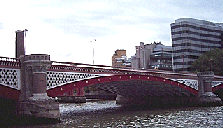 Mylne's bridge was demolished in
1860 and a temporary bridge erected in its place. The corporation
originally accepted a design by Thomas Page for a three-arch bridge, but at
the same time the London Chatham & Dover Railway wanted a railway bridge,
and since the railway bridge required five arches, the road bridge had to be
amended to five. After two years Joseph Cubbit, was appointed to design
both bridges. To overcome tidal scour Cubbit sank massive iron caissons
into the river clay and half filled them with concrete. On to these he
built up his piers in granite-faced brickwork. The spans, two each of
155 ft and 175 ft on either side of the 185 ft centre are formed of
wrought-iron ribs. Mylne's bridge was demolished in
1860 and a temporary bridge erected in its place. The corporation
originally accepted a design by Thomas Page for a three-arch bridge, but at
the same time the London Chatham & Dover Railway wanted a railway bridge,
and since the railway bridge required five arches, the road bridge had to be
amended to five. After two years Joseph Cubbit, was appointed to design
both bridges. To overcome tidal scour Cubbit sank massive iron caissons
into the river clay and half filled them with concrete. On to these he
built up his piers in granite-faced brickwork. The spans, two each of
155 ft and 175 ft on either side of the 185 ft centre are formed of
wrought-iron ribs.
From the cutwaters columns of
polished red granite were erected to support pulpit-like bays at pavement
level. These were embellished by the sculptor J B Philip with sculpted
birds and flowers in honour the original Black Friars. On the upstream
side these show plants and freshwater birds, while on the downstream side
they depict marine vegetation and seagulls. The low cast-iron
balustrade completes the 'Venetian-Gothic' effect. The bridge is 923 ft
long and 70 wide.
On 6 November 1869 the Queen
Victoria opened the new bridge by driving over from the Surrey bank.
She then carried on to inaugurate the newly-completed Holborn Viaduct
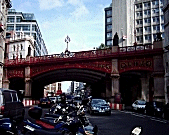
|
|
Putney Bridge
Fulham/Putney, London
SW6 and SW15
|
|
|
|

|
|
Putney Bridge
is world-famous as the starting point of the annual Oxford and Cambridge University Boat Race.
For hundreds of years there was
no bridge between London Bridge and Kingston
Bridge and the only way to cross the
Thames was by ferry. Although the
ferry owners and City Corporation were firmly opposed, Sir Robert Walpole and
his successors successfully petitioned Parliament for a bridge, and in 1726
an Act authorised the construction of a bridge, provided the ferry owners
were fully compensated.
Work began in March 1729 and it
was opened in November of the same year. The curving timber bridge was
supported by 26 arches. Toll-houses stood at either end.
The bridge was the subject of one
of J W M Turner's famous riverscapes but like all timber structure the bridge
needed a considerable maintenance. When three central sections were
damaged by a barge in 1870, there was an ideal opportunity to create a wider
central span.
In 1871 -2 two piers were removed
and replaced by a 70 ft iron girder. Putney Bridge
was purchased by the Metropolitan Board of Works (MBW) in 1879 and, within a
few months, the new owners proposed to construct a new bridge.
The new structure was built
upstream on the site of the former aqueduct. Designed by Sir Joseph
Bazalgette, the present bridge is 700 ft in length and 43 ft wide and
constructed from concrete and granite. Work began in 1882 and the bridge was
opened by the Prince and Princess of Wales in
1886.
|
|
Putney Railway
Bridge
Hurlingham/Putney, London
SW6 and SW15
|
|
|
|

|
|
A railway was built to the north
end of the present bridge in 1880. Passengers alighting at the station
there could make their way along a footway to a new low-water pier, where
there were connections to pleasure steamers.
In 1886 an Act of Parliament
authorised the London & South Western Railway (L&SWR) to start
building a railway line connecting Putney Bridge Station with Wimbledon.
Designed by W H Thomas and
William Jacomb , the wrought-iron bridge is an eight-span girder
structure. It was never given a name but soon became known as the 'Iron Bridge'
by the locals.
The first trains to cross the
Thames on the Wimbledon and Putney branch
ran on 3 June 1889.
A footway on the downstream side,
with an ornamental cast-iron parapet, was opened the following month.
The bridge now forms part of the
District Line service from Wimbledon via
Earl's Court to Edgeware Road
and
Upminster.
|
|
Twickenham Bridge
Old Deer Park/St Margaret's, Richmond,
and Twickenham
|
|
|
|

|
|
Although first recommended in
1909, Twickenham
Bridge was not opened
until 1933.
Twickenham Bridge was part of a major rebuilding
and improvement scheme for the Great
Chertsey Road. Chiswick
Bridge and Hampton Court
Bridge were also part
of the plan.
Twickenham Bridge
runs from Chertsey Road,
on the Surrey side, through the Old Deer Park to join the road to Richmond. At the
time there was local objection to the construction of the bridge because its
approach cut through the Old Deer Park.
Designed by Maxwell Aryton, the
bridge has reinforced concrete arches and bronze balustrades and lamps, very
similar in design to Chiswick Bridge, but the three river arches of Twickenham Bridge have permanent hinges for
self-adjustment. It was the first large concrete bridge in Britain to be
built on this principle.
It was the second of the three
new bridges to be opened by the Prince of Wales on 3 July 1933.
|
|
Westminster Bridge
Westminster and South Bank, London SE1 and SW1
|
|
|
|

|
|
For centuries London Bridge
was the only crossing in central London, the
next bridge upstream was many miles away at Kingston.
The only crossing at this point
was by the 'Lambeth Horseferry' but this took a long time and could be risky
when the tides were fast.
During the reign of Elizabeth I
several attempts were made to pass an Act authorising a bridge at Westminster but the
City always objected. However, in 1734 Charles Labelye, a Swiss
engineer submitted his plans and in 1736 the Earl of Pembroke and his
followers were granted their Act. This empowered them to hold a lottery
to raise money for the new structure, which became known as the 'Bridge of Fools'.
The foundation stone for the
first pier was laid in 1739 by the Earl of Pembroke. Cast-iron caissons
were driven into the river bed by an engine invented by M. Valoue, a Swiss
watchmaker. Building work hampered by financial problems and the harsh
winters as well as wars in Europe, sabotage
by the watermen, accidents and a small earthquake. Later cracks
appeared in the masonry and in 1747 stones from the fifth arch fell into the Thames.
The Earl of Pembroke died shortly
before Westminster
Bridge was opened in
1750. Labelye, worn out by the ten years of work and worries, retired
to the South of France, where he died in 1781.
The bridge was 1,038 feet long
and 44 ft wide.The bridge, which tended to sway on its foundations, was never
fully trusted. When the old London
Bridge was removed in 1831 the scour
of the river upstream undermined the foundations of Westminster Bridge
and it became dangerous. In 1836 James Walker began piecemeal reconstruction
of the structure over 10 years to complete and when complete he joined
Charles Barry, George Rennie and Thomas Page in submitting designs for a
replacement bridge.
In 1854 work began on a new
bridge, the seven-arch wrought-iron bridge is overall 827 ft long and 84 ft
wide. Opened in May 1862, Westminster
Bridge is painted predominately
green for the Commons benches of the Houses of Parliament, Lambeth Bridge
is painted red for the benches of the Lord's.
It was the construction of Westminster
Bridge that started the
development of the South Bank. Westminster Bridge is now the oldest
bridge in use in London and, apart from the repair of a few cracked ribs in
1924, it has had needed very little repair since it opened almost 150 years
ago.
|
|
Battersea Bridge
Chelsea/Battersea, London
SW3 and SW11
|
|
|
|
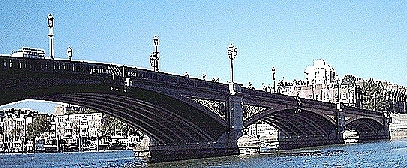
|
|
In 1766 an Act of Parliament was
passed authorising Earl Spencer to construct a bridge across the Thames at Battersea.
The earl, who operated a ferry
here, could not raise sufficient funds to span the river with stone and as a
result the bridge was build with timber. The bridge had 19 spans and
was built in 1771 - 72, but was extremely unpopular because its narrow spans
made navigation very difficult. River traffic often collided with the
bridge and many people were drowned.
In 1795 four of the spans were
made into two by inserting iron girder sections. The piers and wooden
railings along the roadway had to be repaired so frequently that soon little
of the original fabric remained. Between 1821 - 24 the wooden fences
were replaced by 4 ft-high iron railings.
The timber bridge was the subject
of a series of paintings by James Whistler.
The opening of the Victoria Bridge in 1858 brought a drop in
revenue for Battersea tollbridge and when the bridge was purchased by the
Metropolitan Board of Works, they found it in need of replacement.
The Board's engineer, Sir Joseph
Bazalgette, designed a new five-span bridge. After a temporary bridge
was completed in 1885, work on the new bridge in 1886. The
wrought-iron and steel cantilever bridge has five segmental spans. With
two footpaths, the bridge has a total width of 55 ft.
|
|
Hammersmith Bridge
Hammersmith, London
SW13 and W6
|
|
|
|

|
|
The elegant, green-painted Hammersmith Bridge is an important landmark in the
University Boat Race. Today, however the bridge is closed to
pedestrians during the race.
In 1824 an Act of Parliament
authorised the building of Hammersmith
Bridge and the
foundation stone was laid by the Duke of Sussex the following year.
Designed by William Tierney
Clarke, this was the first suspension bridge to span the Thames.
Tierney Clark, a resident of Hammersmith, is buried in the parish
church and his memorial stone bears the outline of the original Hammersmith Bridge.
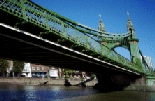 Opened in 1827, the stone bridge
had two brick piers, above which stood two towers with arched entrances in
Tuscan style. Eight chains were strung from these towers to hold the
bridge in place. The timber deck gave a carriageway of 20 ft and two 5
ft pavements, all narrowing to pass under the arches. Octagonal toll
houses were built at either end to control traffic flow on the bridge. Opened in 1827, the stone bridge
had two brick piers, above which stood two towers with arched entrances in
Tuscan style. Eight chains were strung from these towers to hold the
bridge in place. The timber deck gave a carriageway of 20 ft and two 5
ft pavements, all narrowing to pass under the arches. Octagonal toll
houses were built at either end to control traffic flow on the bridge.
By the 1870s Hammersmith Bridge
was not strong enough to support the weight of the heavy traffic and the
owners were alarmed in 1870 when 11,000 - 12,000 people crowded onto the bridge
to watch the University Boat Race. In 1884 a temporary bridge was put
across the river and and work started on a new bridge.
Designed by Sir Joseph
Bazalgette, the elaborate new suspension bridge was opened in 1887. The
wrought-iron framework on the towers and cross-beams was clad in ornamental
cast-iron casings to give the appearance of arches. The bridge is 700
ft long and 43 ft wide and carries a 27 ft-wide carriageway.
Bazalgette's bridge is still in
use today but in recent years it has been strengthened. In June 2000 Hammersmith Bridge was the target of a terrorist
bomb attack, and after repairs the bridge was re-opened subject to a 7.5
tonne weight limit and with a priority measure in place for buses.
At night Hammersmith Bridge
looks stunning, the result of a new lighting scheme which was installed in
1999/2000.
|
|
Lambeth
Bridge
Westminster and Lambeth, London SW1 and SE1
|
|
|
|

|
|
Lambeth Bridge stands on the site
on an ancient landing stage that was in use as far back as the 13th
century. This landing stage was used to receive the monarch on state
occasions and was also the meeting place of Henry VIII and Cranmer and
Elizabeth I and Archbishop Parker.
Today Lambeth
Bridge is approached from the north
by Horseferry Road,
a reminder that this was a river crossing before the construction of Lambeth Bridge. The dangerous
horse-ferry, which operated between Lambeth and Millbank, was under the control
of the Archbishop of Canterbury, whose London
residence is at Lambeth
Palace. After Westminster Bridge was completed in 1750 the
Archbishop surrendered his lease but received compensation for loss of
revenue.
As the population of Lambeth
grew, there was a need for a new bridge to serve the locality.
Although an Act was passed in 1809 authorising a bridge at Lambeth,
insufficient funds to build the structure meant that the bill eventually
lapsed.
In 1860 the Lambeth Bridge
company finally succeeding in obtaining another Act and sufficient funds to
build a bridge. Designed by P.W. Barlow and opened in 1862, the new
suspension bridge from Church
Street, Lambeth, to Market Street, later renamed Horseferry Road
in Westminster,
had three massive iron arches.
The bridge originally charged a
toll but in 1879 these were abolished. By this time the bridge had
rusted and had become unsafe and in 1887 major repairs had to be carried
out. The decision to rebuild the bridge was taken five years later but
nothing was done and in 1905 a weight restriction was imposed on vehicles ,
while gates were erected at either end to regulate the number of
pedestrians. A few years later the bridge was forbidden to vehicles
altogether.
After a temporary footbridge was put
across the river, work finally started on the new bridge in 1929. The
new five-span bridge, designed by George Humphreys, was made of steel and
reinforced concrete, with polished granite facings.
Lambeth Bridge is 60 ft wide and
776 ft long, with a central span of 165 ft.
Originally, decoration was
confined to the parapets and lamp standards, but to mark the opening of the
bridge by King George V and Queen Mary in 1932, lattice-work pylons were
added at either end. These obelisks are topped with pineapples, symbols
of friendship and hospitality.
To celebrate its proximity to the
Houses of Parliament, Lambeth Bridge is painted predominately red for the Lord's
benches, Westminster
Bridge is painted green
for the Common's benches.
|
|
Southwark Bridge
The City and Southwark, London
SE1 and EC4
|
|
|
|
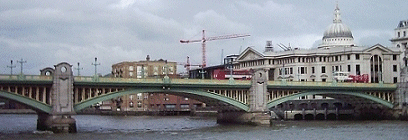
|
|
As the population of London grow during the Industrial Revolution it soon
became apparent that a new bridge was needed over the Thames.
The Southwark Bridge
Company, founded in 1813, commissioned John Rennie to designed the new
bridge, to be built 300 yards from the ancient riverside harbour of
Queenhithe.
The new cast-iron bridge, with
three flat arches, was given approval, even though the Corporation of London
and Thames Conservators had objected to its construction as the Corporation
disliked the idea of a private tollbridge, while the Conservators believed
that building it would be hazardous to navigation.
To solve the problem of
navigation the design included one of the largest cast-iron arches ever
built.
Southwark Bridge opened in 1819 but, with
inadequate approaches, a humped roadway and was a toll the crossing proved
unpopular and was little used.
When Southwark Bridge
was freed of tolls in 1864 it soon began to take its share of traffic.
However, by the end of the 19th century the structure was considered too
narrow to cope with the increased volume of traffic and the decision was made
to replace it.
In 1913 the demolition work
started on the old bridge, but due to World War I it was not completed until
1921. The new bridge has five steel arches supported by turreted piers.
Its five spans, two each of 123 ft and 131 ft on either of a 140 ft
arch, were designed so that the river piers line up with those of Blackfriars Bridge
and London Bridge.
The unusual pierced turrets which
give the bridge its somewhat old-fashioned appearance were designed by Sir
Ernest George RA. At night it is lit by distinctive lamp standards,
each bearing three lamps.
|
|
Vauxhall Bridge
Vauxhall and Kennington, London
SW1 and SE1
|
|
|
|

|
|
In 1809 an Act of Parliament
authorised one more bridge, and Vauxhall
Bridge was conceived as part of a
great new thoroughfare from Hyde Park Corner to Greenwich.
In 1811 the foundation stone was
laid by Lord Thomas Dundas, standing in for the Prince Regent. Originally
named Regent's Bridge, the name Vauxhall
Bridge was restored
during construction. Designed by the engineer James Walker, this was
the first iron bridge to span the Thames.
The nine-arched cast-iron
structure stood in deeply embedded stone, faced with granite, 809 ft and 36
ft wide. Tolls were charged after the bridge opened in 1816 but in 1879
these were abolished.
Tidal scour had made the piers in
a dangerous condition. Repairs to the bridge were too expensive but the
construction of a new bridge was delayed. A temporary wooden bridge was
thrown out across the river and demolition work began in 1898.
However, work on the new
structure did not begin until 1904. The present bridge five-arch steel
bridge was designed by Sir Maurice Fitzmaurice. The five spans
make up a crossing of 809 ft, with a width of 80 ft.
Vauxhall Bridge was opened in 1906 by the Prince
of Wales (later George V). The bridge was the first in London to carry
trams.
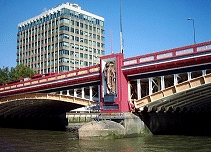 Vauxhall Bridge is unique in having its piers
decorated by heroic-sized bronze statues. Vauxhall Bridge is unique in having its piers
decorated by heroic-sized bronze statues.
Sculpted by Frederick Pomeroy and
Alfred Drury, these female figures represent the Arts and Sciences. The
figures facing downstream, towards Westminster,
represent Local Government, ducation, the Fine Arts, and Astronomy.
Facing upstream away from London are figures
representing Agriculture, holding a scythe, Architecture, holding a
model of St Paul's
Cathedral, Engineering, holding an engine and Pottery, holding a vase.
|
|
|
|
Battersea Railway
Bridge
Chelsea/Battersea, London
SW10 and SW11
|
|
|
|

|
|
Opened in 1863, the five-arched Battersea Railway
Bridge carries London's only north-south
through-route.
The bridge was part of the West
London Extension Railway, connecting the main lines radiating to the north,
out of Paddington and Euston, with lines running south from Waterloo, Victoria
and Clapham Junction.
To cross the 706 ft wide river
the construction company built a 1,270 ft viaduct. The track was not only
laid for standard gauge, but also the GWR's broad gauge.
Its opening led to a significant
increase in freight traffic but passenger services did not commence until
1904. In 1979 long distance passenger services resumed with daily return Manchester - Brighton
Inter-City
services. These trains also serve the increasingly busy Gatwick Airport.
A major problem with Battersea Railway Bridge
is that trains crossing it are restricted to 15 miles per hour. This
gives the bridge the distinction of being the slowest railway crossing on the
Thames.
|
|
Chelsea Bridge
Chelsea/Battersea, London
SW1 and SW8
|
|
|
|
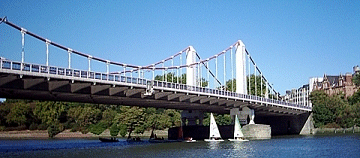 Following the construction of Westminster Bridge in 1750, the population of the
city grew eastwards and westwards along both banks of the river. Following the construction of Westminster Bridge in 1750, the population of the
city grew eastwards and westwards along both banks of the river.
In the 19th century the suburbs
of Fulham, in the north, and Battersea, in the south, had expanding
populations.
Work began on the suspension
bridge in 1851 to the designs of the engineer, Thomas Page. The ornate
bridge had pairs of domed toll houses, encrusted with Gothic-syle decoration,
at each end. In 1879 Chelsea
Bridge became
toll-free.
Although never formally named,
the bridge was known as the Victoria
for some years after its opening in 1858. The change of name coincided
with fears over the bridge's safety, and in 1880 the bridge was strengthened
with additional chain, but only 40 years later it was recommended that the
bridge should be completely replaced.
Demolition work in 1935, the new
suspension bridge was given stronger foundations, set inside granite bored
into the riverbed. The six-lane roadway of Chelsea Suspension Bridge
is suspended using 37 galvanised steel wires. The bridge is embellished
with lampstands decorated with golden galleons.
Because the construction work
used Douglas Fir from British Colombia in Canada, the Prime Minister of
Canada, W.L Mackenzie King, opened the bridge in 1937.
|
|
London Bridge
The City and London Bridge, London
EC4 and SE1
|
|
|
|

|
|
These is no written record of a
bridge here until about AD 984, but excavations in 1981 uncovered what
may have been the foundations of one of the piers of a Roman bridge.
The wooden bridge was a barrier
against the Danes who regularly sailed up the Thames
to fight the Anglo-Saxons. Nevertheless, in 1014 the Danish King Olav
managed to sail right up to the bridge and destroyed the piles supporting the
bridge, and the bridge and the defenders collapsed into the Thames.
This is believed to be the origin of the nursery rhyme 'London Bridge
is falling down'.
The bridge was rebuilt of wood
over the years and used as the main defence against invaders. The last timber
bridge was built in 1163.
Work on a new stone bridge
started in 1176 and took 33 years to complete. It was 926 ft long and 40 ft
wide and was supported by 20 arches with a drawbridge. For 600 years,
until Westminster
Bridge was built in
1750, this was the only bridge in the city.
The drawbridge was set in the
seventh span from the Southwark side and was protected on the capital's side
by a gatehouse known as the Drawbridge
Tower. The tower
served as the place of exhibition for the severed heads of people executed at
the Tower of London. The display of heads was
later transferred to the Southwark Gate, complete with portcullis, on the
second pier from the Southwark side. This gate was the main bastion of
the bridge and the city's southern defences.
Over the years many houses and
shops were built on London
Bridge. This was
seen as a way of raising revenue for the upkeep of the bridge. The
buildings projected over both sides of the bridge, and one of the first
buildings was the Chapel of St Thomas à Becket.
During the reign of Elizabeth I
the bridge was restored and many new buildings were added, including a
water-mill at the northern end of the bridge. Following fires and the Great
Fire of 1666, by the middle of the 18th century the bridge and its buildings
were in poor condition and the buildings were removed for both health and
safety reasons.
In 1823 Parliament approved John
Rennie's design for a new
London Bridge. The
foundation stone was laid by the Lord Mayor of London in 1825 and opened by King William
and Queen Adelaide in 1831. The new bridge was over 1,005 ft long and
56 ft wide.
The bridge lasted 140 years but
it was too narrow and too weak to cope with the traffic. In 1967 work
began on demolishing the old bridge, and the new bridge was opened by Queen
Elizabeth II in 1973. The bridge has a 105 ft wide roadway with room for
6 traffic lanes and two footpaths.To prevent icing in freezing conditions, a
heating system was built below the surface of the roadway and pavements.
The old London
Bridge was sold and shipped out in
sections to Lake Havasu City in Arizona, USA. Lake Havasu
is an artificial stretch of water. Today, it is the focal point of annual London Bridge days held in early October,
with the people of Havasu dressing up as Elizabethans, archery contests,
pancake races, and square dancing.
In 1984 the Royal Navy warship
HMS Jupiter hit London
Bridge broadside.
The ship suffered considerable damage to her superstructure and the granite
parapet of London
Bridge was dislodged.
Now and then London Bridge
still witnesses the traditional walking of a flock of sheep into the City - a
right of all who are Freemen of the City of London.
|
London Bridge
History
A
bridge has existed at or near the present site for nearly 2000 years. The first
bridge across the Thames in the London
area was built by the Romans on the present site around AD 50 and was made
of wood. The location was likely chosen as a bridgable spot which still had deepwater
access to the sea. The bridge fell into disrepair after the Romans left, but at
some point either it was repaired or a replacement constructed. In 1014 it was burned down
by King Ethelred in a bid to divide the invading
forces of the Dane Svein Haraldsson. This episode reputedly inspired
the well-known nursery rhyme London Bridge is falling down.
Old London
Bridge

The reconstructed
bridge was destroyed by a storm in 1091 and destroyed yet again, this time by fire, in 1136. A stone bridge
was begun in 1176
although it was not completed until 1209. This was soon colonised by houses, shops and even a chapel
built at the centre of the bridge. Contemporary pictures show it crowded with
buildings of up to seven storeys in height. It had 19 small arches and a drawbridge
with a gatehouse at the southern end. The narrowness of the arches caused
ferocious river currents; only the brave or foolhardy attempted to "shoot
the bridge", and many were drowned trying to do so.
The
southern gatehouse became the scene of one of London's most notorious sights: a display of
the severed heads of traitors, impaled on pikes and dipped in tar to preserve
them against the elements. The head of William
Wallace was the first to appear on the gate, in 1305, starting a
tradition that was to continue for another 355 years. Other famous heads on
pikes included those of Jack Cade in 1450; Sir Thomas More in 1535; Bishop John Fisher,
also in 1535; and Thomas
Cromwell in 1540.
A German visitor to London
in 1598 counted over
thirty heads on the bridge. The practice was finally stopped in 1660, following
the Restoration of King Charles II.
The
buildings on London
Bridge created a major
fire hazard and served to increase the load on its arches, so it is not
surprising that there were several disasters. In 1212 or 1213 a major fire broke
out on both ends of the bridge simultaneously, trapping many in the middle and
reportedly resulting in 3,000 people being killed. Another major fire broke out
in 1633 with half of
the bridge being destroyed. By 1722 congestion was becoming so serious that the
Lord Mayor decreed that "All carts, coaches and other carriages coming out of
Southwark into this City do keep all along the west side of the said bridge:
and all carts and coaches going out of the City do keep along the east side of
the said bridge". This is possibly the origin of traffic in Britain driving
on the left. Finally, in 1758-1762,
the houses were removed along with the two centre arches, replaced with a
single wider span to improve navigation on the river.
New London Bridge
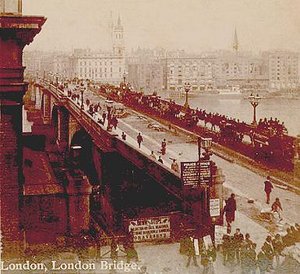

New London Bridge in the early 1890s
By the
start of the 19th century, it was apparent that the old London Bridge - by now
over 600 years old - needed to be replaced. It was narrow, decrepit and a
hazard to river traffic. In 1799, a competition for designs to replace the old bridge was
held, prompting the engineer Thomas
Telford to propose a bridge with a single iron arch spanning 600ft. The
revolutionary nature of this design won praise but it was never used, due to
uncertainty about its feasibility and the amount of land needed for its
construction.
The
bridge was eventually replaced by an elegant structure of five stone arches,
built 100 feet west (upstream) of the original site. This was designed by
engineer John Rennie and completed by his son (of the
same name, confusingly) over a seven-year period from 1824 to 1831.
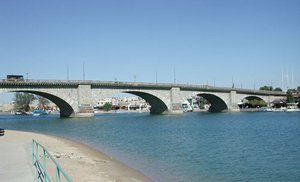

The rebuilt London Bridge in Lake
Havasu, Arizona
It was
constructed from Dartmoor granite, with a length of 928 feet and a width of 49 feet. It
was widened in 1902-1904 in an attempt to
combat London's
chronic traffic congestion. Unfortunately, this proved too much for the
bridge's foundations; it was subsequently discovered that the bridge was sinking
an inch every eight years.
In 1968, Rennie's bridge
was sold to the American entrepreneur Robert P. McCulloch for the sum
of $2,460,000 (it has been claimed that he was under the mistaken belief that
he was buying Tower Bridge). The bridge was shipped piece by piece
to Lake Havasu City, Arizona, where it was
reconstructed and dedicated on October 10, 1971. (Not all of the bridge was transported to America; some
was kept behind in lieu of taxes and was eventually auctioned in 2003.) Today it forms
the centrepiece of what amounts to an ersatz English theme park complete with
mock-Tudor shopping mall. Somewhat surprisingly, Rennie's London
Bridge has become Arizona's
second biggest tourist attraction after the Grand
Canyon.
Modern London
Bridge
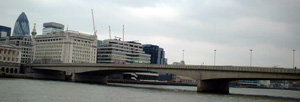
The
current London Bridge was constructed in 1967-1972 over the River
Thames and opened in 1973. It is a fairly dull edifice comprising three spans of
pre-stressed concrete cantilevers, paid for in part by the sale of the earlier
Rennie bridge. Its cost of £4m was met entirely by the City of London's Bridge House Estates.
|
Richmond Bridge
Twickenham and Richmond
|
|
|
|

|
|
This is the oldest Thames bridge in Greater London.
Before Richmond Bridge
opened in 1777, a ferry owned by the Crown operated at this point on the
river. Henry VIII and his daughters Mary I and Elizabeth I spent a good
deal of time at Richmond
Palace. There were two
boats, one for passengers and another, for horses, small carts and
goods. Carriages were too heavy and had to travel upstream and cross at
Kingston Bridge.
In 1760 William Windham, the ferry lessee, petitioned
Parliament for a Bill. However, there were strong objections, the
inhabitants of Richmond
did not like the idea of a wooden bridge and they did not want a privately
owned toll bridge. Although the idea of a stone bridge was accepted the
bridge was built the proposed site, on the line of the ferry.
Designed by the architects James
Paine and Kenton Couse, the bridge was built in 1774 - 77. The bridge
had gates and at each end were lodges for the toll-collectors.Tolls were removed
eventually and the gates were taken down, the lodges survived for
another 50 years.
Richmond Bridge has 13 arches. The five
river arches are made of stone while three arches on the Surrey
side and a causeway on the Middlesex side are made of brick. On the Surrey side the interior parts of the brick arches have
been converted for private use.
Richmond Bridge
was transferred to the counties of Surrey
and Middlesex in 1927. In 1937 - 39 the bridge was widened on the
upstream side. Each stone was removed, numbered and replaced after the
piers and cutwaters had been extended. The new work can still be seen
on the undersides of the arches.
|
|
Wandsworth Bridge
Hurlingham/Wandsworth, London
SW6 and SW18
|
|
|
|

|
|
Although authorised in 1864, the
bridge was finally built in 1873. Designed by Julian Tolmne, the
wrought-iron structure was of the lattice girder type, with a timber roadway.
When it opened a toll was charged
but this was abolished in 1880. By this time the bridge had been
purchased by the Metropolitan Board of Works. The new owners decided
that the bridge should be replaced. In 1935 London County Council (LCC)
finally gave their consent for a new bridge. A temporary bridge, used
during the widening of Chelsea
Bridge, was erected
alongside the old one.
Designed by Sir Peirson Frank,
the new bridge has a 200 ft central span, consisting of seven high-tensile
steel girders. After some delay the new bridge opened in 1940.
|




![]()

![]()
